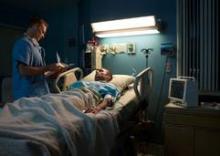A quality improvement program cut postoperative pneumonia rates by 43.6%, investigators reported July 23 in JAMA Surgery.
The small, single-center retrospective cohort study is the first to present long-term findings for such a program, said Dr. Hadiza Kazaure at Stanford (Calif.) University and her associates.
The program, which investigators started at a Stanford-affiliated Veterans Affairs hospital, included coughing and deep-breathing exercises with incentive spirometry, a twice-daily oral chlorhexidine hygiene, ambulation with pain control, elevating the head of the bed by 30 degrees and sitting for meals, educating surgical nursing staff about their roles in preventing pneumonia, and automating physician orders for pneumonia prevention, the researchers said (JAMA Surg. 2014 July 23 [doi:10.1001/jamasurg.2014.1216]).
The investigators calculated postimplementation rates of ward-acquired pneumonia in all noncardiac, unventilated surgical patients in the 5 years after the program started, they said.
Among 4,099 hospitalized patients who were at risk, 18 (0.44%) developed postoperative pneumonia, a 43.6% drop from the preprogram rate of 0.78%, the investigators reported.
By comparison, the postintervention rate for the American College of Surgeons National Surgical Quality Improvement Program (ACS-NSQIP) was 582% higher than that of the VA hospital for 2008-2012. By achieving the VA hospital program’s results, the hospitals in the ACS-NSQIP could save about $280 million, Dr. Kazaure and her associates said.
The database abstraction methods used to choose patients were validated, but nonetheless could have caused selection errors. Also, few patients developed pneumonia, which kept the investigators from tracking trends over time on the ward, they said. "Based on published data, we used a national average of $46,400 cost of care per postoperative pneumonia case to estimate potential cost savings in our analyses," they added. "The validity of cost estimates in this study to individual hospitals must be considered because geographic variation in cost of care is well established."
The authors reported no funding sources or conflicts of interest.

